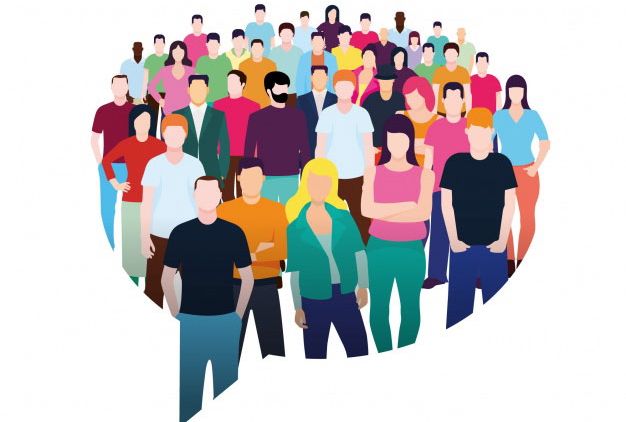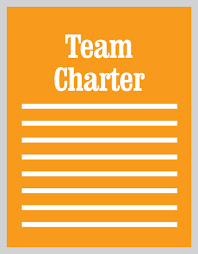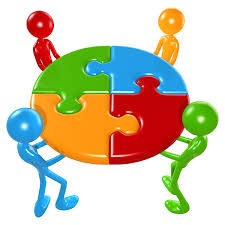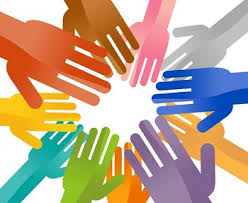Understanding Group Dynamics
There is no specific definition of a group. Some feel that two or more persons interacting with each other form a group. Other definitions state that for a body of persons to be perceived as a group there should be a degree of structure or permanency. In a general sense we can say that a group is a collection of people who interact with each other and perceive themselves as a single unit. They work together in harmony to achieve a common set of goals. In a workplace, groups are very important irrespective of whether they are formal groups or informal.
They give a sense of belongingness to an individual and bring out the best in performance, enthusiasm and creativity. Kurt Lewin described group dynamics as how individuals and groups act and react to changing circumstances. It is a system of behaviors and psychological processes occurring within a group or between groups. The study of group dynamics helps us to understand decision making, leadership, the reasons for conflicts in a work environment and creating effective therapy techniques.
The question that arises is that why do we really join groups? Why can’t people just work individually? There are a variety of reasons for that. They can be categorized in the following way.

1. Synergy
In a professional environment the most common reason for joining a group is to complete the task assigned to them. Now there is limit to what an individual can achieve due to physical and emotional constraints. However if many people work together they can accomplish well beyond the total member’s individual capability. Thus, a group helps in creating synergy. A whole that is more than the sum of its parts. Group synergy is necessary to become competitive and complete tasks in the most efficient way in today’s dynamic business environment.
2. The Need to Belong and Affilation
Man is a social being. He constantly seeks company of others and cannot live in isolation. Research has demonstrated the one’s need for affiliation is very strong. Mayo found that employees at a textile plant who worked separately from others were not as satisfied as the ones who had the opportunity to work with others. Thus, man likes to work in groups rather than alone.
3. Identification
It is the need of an individual to associate with image projected by other people or groups. Most individuals belong to various groups, but many of these memberships do not have an influence on their social identities. In some groups however, a person identifies himself with social categories and accepts the group as an extension of him. They feel connected to the members and the cause for which the group exists.
4. Emotional Support and help
People joins various groups for emotional support and for help. It is a very common tendency of an individual to be attracted to those people who may have suffered something they have too. An example of this may be various anonymous groups created by ex-alcoholics who talk about their journey and how they dealt with their addiction. Even in a school, students form various groups so that they can help each other and solve their problems.
5. Common Interest and Goals
Individuals also become a part of a group because the share some common interest and are enthusiastic to talk about it and share their experiences. Today, many people have formed reading clubs online so that they can freely talk what captivated their interest among other things.

Every start up today wants to be successful. However, even if you have a great product, the best of resources and highly skilled manpower you mail fail. This is because if you don’t have an efficient and effective team all you can hope for is a mediocre product at best. In today’s dynamic environment businesses spend huge gallons of time to get the most experienced and innovative individuals. Of course, having these individuals with you is a valuable asset but these individuals also need to work together in order to meet their goal.
So what does it really take to get the best of a group of people?
What are the factors that affect group performance?
Group Cohesiveness
Group cohesiveness is the extent to which group members like and trust one another, are committed to accomplishing a team goal and share a feeling of group belongingness and pride. Social cohesion is like a double edged sword. Normally, the more cohesive the group is, the more is the productivity, efficiency, and decision making quality. But cohesiveness can also reduce the quality of group performance. This is because when group members become too close they start giving more importance to their personal needs than the needs of the customers. Sometimes they may also not work to their full capacity just because others cannot keep up or it is against the group norms. It can generate bias, prejudice and ‘us versus them’ mentalities.
Group Homogeneity
A homogeneous group is one in which the members have similar characteristics. On the other hand, a heterogeneous group is one in which the members are more different than alike. It is not easy to determine the homogeneity of a group because each individual is unique and has different values, beliefs and personality. Many studies have been conducted to determine which type of group is better. Mixed results have been found. The leader needs to decide the composition of a group keeping in mind what he wants the group to accomplish.
Stability of Members
Stability here means the extent to which the membership of a group remains consistent over time. The greater the stability of the group the more efficient it will be. This is because when the members have previously worked together, they know the strengths and weaknesses of each other and work accordingly. The longer the group stays together, the longer they start to think similarly, act similarly and live similarly.
Group Size
While creating a group, sensitivity to size is ubiquitously important. Usually small groups are better. This goes with the saying ‘Too many cooks spoil the broth’. Studies have shown that larger groups are less cohesive, less coordinated and have lower morale than small groups. Large groups also face logistical issues, such as finding enough physical space and time to meet. When large teams try to develop a common purpose, all they are able to produce are superficial tasks rather than concrete objectives.

Thus, even a large organization works better when it is divided into smaller departments, committees and teams. However, in case of additive tasks where the group’s performance is the sum total of its members, a larger group is better. Examples of these may be bowling groups and typing pools. The group size should be determined keeping in mind the nature of the task and maturity of the group members.
Group Ability and Confidence
Undoubtedly, if the members of the group are highly skilled the performance of the group is also better. If the members believe that they can achieve a task and are confident in themselves they can outperform those who are not confident about their success.
Communication Structure
The manner in which members of a group communicate with each other has a significant impact on the performance of the group. Effective communication will lead to transparency which will result in better understanding and coordination among group members. A variety of networks may be used and each network has its own merits. For example, if the goal of a fraternity is to know one another better then a centralized will be less conductive than an open one. While if the goal is to solve a problem as quickly as possible a centralized structure will be better suited.
What is a group conflict? How does it arise?
Conflict is the psychological and behavioural reaction to a perception that is different from that of another. In a group there are various people who differ in the way of their personality, their style of working and how they perceive things. This is really good as it bring different skills and perception to the workplace. Every coin however has two sides.
These very differences among individuals can be the reason for conflicts, which prevents smooth flow of work and damages relationships. It is important to note that one of the key components to conflict is perception. People of the group may share the same goal but they may perceive it in a different way or choose an action to reach that goal which is incompatible. This will lead to conflict.
Conflict can be divided into the following types:
Interpersonal Conflict
It refers to the conflict between individuals. This basically occurs because each individual differs from another in various ways. Varied personalities lead to incompatible choices and opinions. Experts believe that there can be three components to these types of conflicts. The behavioural component involves someone interfering with the aims and objectives of another person. For example, you want to make a presentation however your colleague disturbs intentionally so that you may not be able to give that presentation and get promotion. The cognitive component involves a disagreement between the parties that illustrates the differences between the interests and objectives of conflicting parties. For example the finance manager may have a disagreement with the marketing manager because each has different goals and objectives. The third one is affective component which generally relates to negative emotional states. However, when these types of conflicts become too destructive calling a mediator can help resolve it.
Intrapersonal Conflicts
This type of conflict occurs within an individual. It is a psychological conflict involving an individual’s contrasting values, beliefs or emotions. For example, you are a part of an informal group whose norms indicate that you should work share everything with them about your work but you know some confidential information that you cannot disclose because your superiors have trusted you with it.
These types of conflict may range from simpler one like deciding whether you want to have tea or coffee to major one that may have a direct impact on your career. These conflicts may lead to frustrations, restlessness and have negative effects on your work performance.
Intragroup Conflicts
Conflicts among group members come under this category. They may happen due to misunderstanding between individuals due to interpersonal disagreements or differences in views and ideas. Within a team, conflict may sometimes be good to. It may be constructive. When different members suggest their own plans to achieve a desired goal the team can integrate all the opinions and decide the most efficient way. In another case, if the conflict may disrupt the harmony among members it may pose serious threats for a group as a whole. It may require expert guidance.
Intergroup Conflict
This type of conflict occurs between two or more groups. Such group-group conflicts occur annually as various departments fight for budget allocations and space. So these types of conflicts usually occur due to varied sets of goals and interests of different groups. In addition, competition also gives rise to intergroup conflict.
How to improve group dynamics at work?
1. Recognise personalities and divide the group into teams
If there is a large number of members in a group then it would be clever to divide the group into smaller teams and assign them specific tasks. While dividing a group into teams there are various factors that require attention. Each person in a team brings something to the table according to his personality and skill set. Recognizing each person’s style of work, level of aptitude and motivation can help him determine the people who will gel together and those who will not. This can also provide an opportunity to the manager to note gaps in experience and behavior that will help him to determine additional tea members.
2. Create a team charter

Individuals in a team need focus and motivation to flourish. Creating a team charter offers well defined roles and encourages members to address their responsibilities and work in harmony with others. It also helps in setting unambiguous expectations and outcomes. It also helps set certain norms which the member should abide by and thus be held accountable in case of inefficient work.
Have Strong Leadership

One of the prerequisites for good group dynamics is a strong leader. This does not imply that the manager needs to bully or strong arm the team to maintain control. A leader should be able to guide the members towards the correct path in case anyone strays away. His should be in constant contact with everyone and constantly motivate them to give full support to the cause. He should be a good communicator, have strong organizational skills and should ensure that members display competency and skill with the available resources in the given time.
Encourage full Contribution

Each and every member should contribute towards the group efforts in the achievement of the goal and should be dedicated towards the group’s progress. If the group is willing to share the effort and to work together toward the aim, individual frustrations can be mollified quickly. If each member shares the work equally then feelings of resentment do not arise. They swim and sink together. More than a century ago, a French engineer discovered ‘social loafing’.
He observed that when only two people were pulling a rope they exerted 97% of their effort but when six more people were added to the task they only used 47% of what they could give. This practice can be discouraged by making all individual contributions identifiable and rewarding good performance.
Make the team Mutually accountable

Every team should openly discuss and establish some ground rules and a code of conduct that should be followed by all its members. There should be rewards as well as penalties so that a group can check itself when a problem arises. While defining rules an open discussion should be conducted. This process makes these rules more egalitarian and difficult to argue against.
Accountability for delivering results is a quality that takes teams to the highest level of performance. Individuals should not only be held accountable for their personal tasks but they should be responsible for the team goals too. There is a huge difference between “the manager holds me accountable” and “we hold ourselves accountable”. The former may lead to the latter but without the later there is no team.
Shared Values
Every member of a group is unique. Individuals perceive according do their own values, beliefs and experiences. Value Incongruities usually give rise to conflicts and arguments. Furthermore, each individual may want to take a different path to achieve a common goal. An open recognition of value differences and attitude toward finding common ground in a respectful and considerate way can solve all problems and create a more conducive environment which will advocate success.
Tackle Problems Promptly
If a member is engaging in unproductive activities or creating misunderstandings it is the responsibility of the leader to look into the matter and provide solutions. To accomplish this he may speak to the person directly to counsel and encourage him to direct his efforts towards the group objectives. It is essential for the tem to be in a state of positive group dynamics so when the team faces challenges and conflicts, the leader should advocate open discussion and help the members to resolve their differences and come to an understanding.
Enhance Team Culture

For a team to be productive it should definitely have a supportive culture. Members should readily offer assistance to each other if required. Regular team building exercises should be undertaken to develop stronger relationships and mutual trust. Teamwork should be one of the core company values and should put clear emphasis on self-managing teams that are empowered to make their own decisions. Another method to improve team culture is feedback. A feedback should be constructive, kind and honest. It should be real yet positive.
Always pay attention
The best managers and leaders are listeners as well as facilitators. In a group, it is essential that the leaders pay attention to what is going on. He should be on the lookout for unacceptable behaviour such as freeriding and bullying so that they are addressed promptly. Reinforce positive behaviour such as successful collaboration, sharing of ideas, trust and respect.
Ensure good communication

Teams of every sort need to communicate to get the job done. That is why every basketball team has a coach who asks for a time out to discuss tactics and quarterbacks yell out plays. Open communication is the key to building good team dynamics. The most valuable form of communication are face to face exchanges and other methods include emails, shared documents and daily chats via group messaging systems. Team effectiveness is also ensured if they have an efficient communication structure so that members are aware of who is communicating with whom and who is out of the network.
When individuals work in groups their decision does not only reflect the intellect of one individual but all of them. Group dynamics plays a critical role in determining the innovation, quality and effectiveness of their decisions which is a key component of management. Thus, a sound understanding of group dynamics is a critical component of successful management. When a group dynamics exists within a group working toward a common goal, each individual member will perform effectively and achieve the goals set by the group. Suppose you have to determine a team for a start-up.
What people usually do is go with their gut feeling and determine their teams but data shows that 60% of new start-ups fail due to issues with the teams. Some people would say that an entrepreneur should ensure that the team members should be skilled and have experience. But this is not sufficient condition for a team to thrive. What is essential is that these teams should work together in cohesion and have passion and vision to achieve success. This is only possible with good group dynamics.
Update your management skills: Take Vskills Certification to move ahead.



